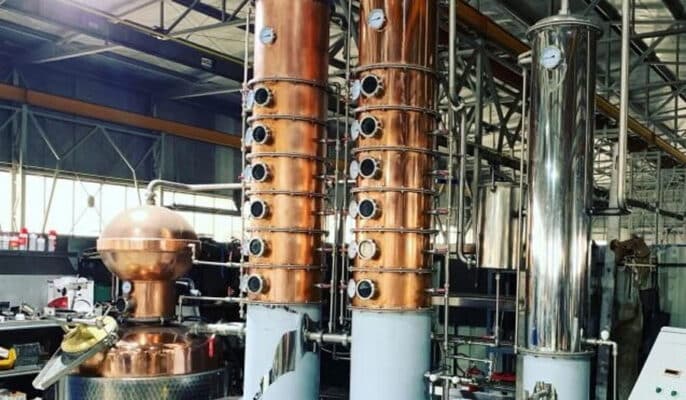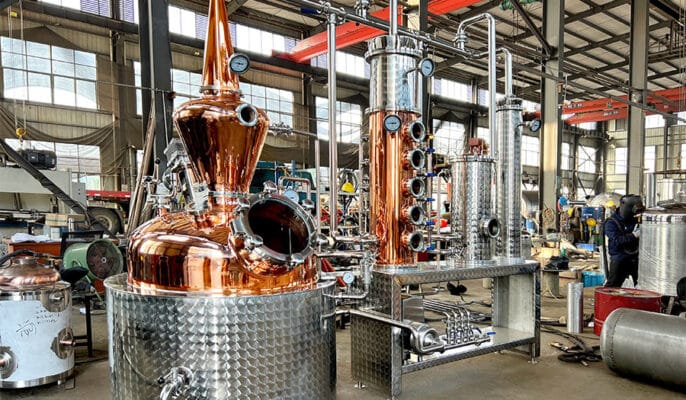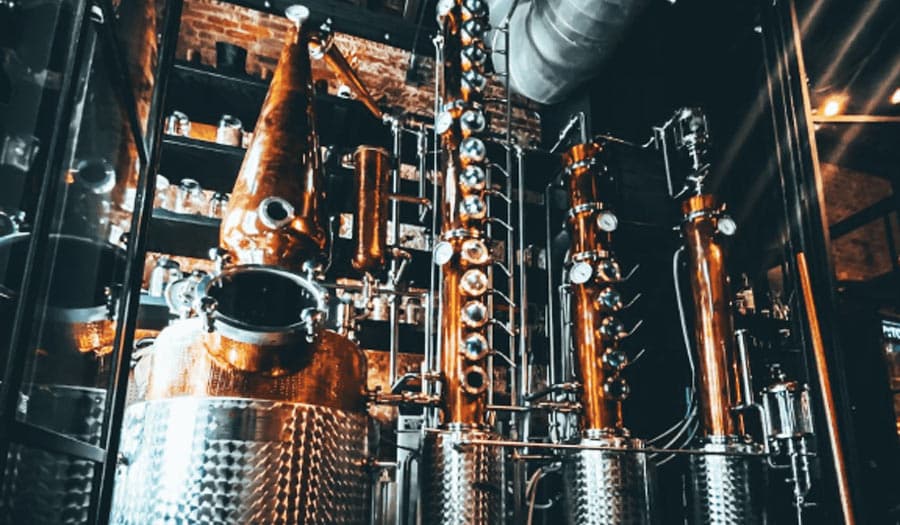Destilliergeräte Die Auswahl und Konfiguration der Destillieranlage hat einen direkten Einfluss auf den Geschmack, das Aroma und die Qualität des fertigen Whiskeys. Egal, ob Sie ein Heimbrauer oder ein kommerzieller Hersteller sind, die Wahl der richtigen Ausrüstung ist entscheidend für die Herstellung von hochwertigem Whiskey. In dieser Kurzanleitung werden die wichtigsten Komponenten der Destillationsausrüstung und ihre Bedeutung für die Whiskey-Destillation beschrieben.
Grundlegendes Verfahren des Whiskey-Brauens
- Mälzerei: Gerste ist einer der wichtigsten Bestandteile von Malt Whiskey und muss speziell verarbeitet werden, um ihren Zucker zu extrahieren. In diesem Stadium wird die Gerste in Wasser eingeweicht und zum Keimen gebracht. Der Keimprozess ist beendet, wenn die Gerste in einer Darre getrocknet wird.
- Maischen: Nach dem Mälzungsprozess ist die getrocknete Gerste bereit zum Maischen. Während des Maischvorgangs wandeln Enzyme Stärke in Zucker um. Sobald der Zucker extrahiert ist, kann die Flüssigkeit (jetzt Würze genannt) in die nächste Stufe übergehen und zu Alkohol werden.
- Die Gärung: Bei der Gärung wird die Würze in einen großen Holzbehälter, den Fermenter, umgefüllt. Hier wird die Hefe hinzugefügt. Durch das Vermischen der Würze mit der Hefe wird der Zucker in Alkohol umgewandelt, der als "Gärflüssigkeit" bezeichnet wird. Dieser Prozess dauert 48-96 Stunden und kann je nach Gärdauer und Hefestamm verschiedene Geschmacksrichtungen hervorbringen. Der Alkoholgehalt der Flüssigkeit vor der Destillation beträgt etwa 7-10%.
- Destillation: Der Trub durchläuft einen Destillierapparat, in der Regel einen "Tresterapparat" und einen "Brennapparat". Der Destillierapparat besteht in der Regel aus Kupfer und trägt dazu bei, unerwünschte Gerüche und Geschmacksstoffe aus der Spirituose zu entfernen. Die Flüssigkeit wird erhitzt und verfeinert, so dass der Prozess erneut ablaufen kann. Die meisten Whiskeys werden zweimal, manche aber auch dreimal destilliert. Am Ende dieser Phase wird eine hochwertige Spirituose hergestellt.
- Reifung: Ein Schlüsselelement des Herstellungsprozesses ist die Reifung. Fast alle Whiskeys reifen in Holzbehältern, den so genannten Fässern, die in der Regel aus Eichenholz hergestellt werden. Die Fässer verleihen dem Whiskey seine Farbe und andere Eigenschaften. Die Fässer werden in Lagerhäusern gelagert, damit der Whiskey reifen kann.
- Die Abfüllung: Nach der Reifung des Whiskeys hat er einen Alkoholgehalt von mindestens 40%. Der Whiskey kann kalt gefiltert werden, um zu verhindern, dass er bei Zugabe von Eis trüb wird.

Arten von Destillieranlage erforderlich für die Destillation Brennereien
Wärmequelle Brennerei
Die Heizquelle wird zum Erhitzen der vergorenen Flüssigkeit im Destilliergerät verwendet, wobei in der Regel zwischen elektrischer Heizung und Dampfheizung unterschieden wird.
- Elektrische Heizung: Das elektrische Heizsystem ist einfach und leicht zu bedienen, kann die Temperatur genau steuern und ist für kleine Brennereien geeignet. Die Kosten sind jedoch hoch, und bei langfristiger Nutzung steigen die Stromrechnungen.
- Dampfheizung: Bei der Dampfheizung wird ein Kessel zur Dampferzeugung verwendet und der Dampf über eine Leitung in die Brennerei geleitet. Der Vorteil dieser Methode ist die gleichmäßige Erwärmung und sie eignet sich für die Großproduktion, erfordert aber komplexere Anlagen und Wartung.
Brenner
- Pot Still: Der Pot Still besteht in der Regel aus Kupfer, hat eine runde Form und einen langen Hals an der Oberseite. Diese Konstruktion trägt dazu bei, dass während des Destillationsprozesses mehr Kontakt mit dem Dampf entsteht, wodurch Verunreinigungen wirksam entfernt werden und der Geschmack des Weins erhalten bleibt. Sie eignen sich für kleine Brennereien, die in der Regel nur eine begrenzte Anzahl von Rohstoffen auf einmal verarbeiten können, können mehr Geschmackskomponenten bewahren und sind für die Herstellung von Single Malt Whiskey geeignet.
- Kolonnenbrennerei: Kolonnenbrennereien werden in der Regel für die Produktion in großem Maßstab verwendet. Ihre Struktur ist komplexer und besteht aus mehreren vertikalen Destillationskolonnen. Sie ermöglicht eine ununterbrochene 24-Stunden-Produktion und eignet sich für das Brauen in großem Maßstab. Das Brauen ist effizient und bringt die Alkoholkonzentration in kurzer Zeit auf das gewünschte Niveau.
Verflüssiger
Der Kondensator ist für die Abkühlung des im Destillierapparat erzeugten Dampfes in einen flüssigen Zustand verantwortlich. Er besteht in der Regel aus einer Spirale oder einem Rohr, durch das kaltes Wasser zirkuliert, wodurch der Dampf kondensiert und sich als Destillat sammelt. Der Kondensator kann passiv (unter Verwendung von Umgebungsluft oder Wasser) oder aktiv (unter Verwendung eines Kühlmittels wie Glykol) sein, je nach Größe und Konstruktion der Brennerei.
Fermenter
Die fGärbehälter ist der Ort, an dem der Gärungsprozess stattfindet, bei dem Zucker in Alkohol und andere Verbindungen umgewandelt wird. Für einen Heimbrauer kann das Gärgefäß ein einfaches Fass oder ein Keg sein, für einen gewerblichen Hersteller hingegen ein größerer Tank. Das Gärgefäß sollte aus lebensmittelechten Materialien bestehen und mit Schleusen versehen sein, damit Gase entweichen können und eine Verunreinigung verhindert wird.
Würzwanne
Der Würzebottich dient zum Mischen von Wasser und Getreide oder anderen gärfähigen Zutaten zur Herstellung von Würze. Sie kann einen doppelten Boden oder ein anderes Filtersystem haben, um die Flüssigkeit (Würze) von den Feststoffen (Treber) zu trennen, nachdem die Würze verarbeitet wurde. Würzebottiche sind für die Herstellung von Whiskey, Bourbon und anderen Getreidespirituosen unerlässlich.
Andere Hilfsmittel
- Alkoholmessgerät: Mit einem Alkoholmessgerät wird die Alkoholkonzentration der destillierten Flüssigkeit gemessen, um sicherzustellen, dass der hergestellte Whiskey den Normen entspricht.
- Umfüllpumpe: Eine Transferpumpe wird verwendet, um die vergorene Flüssigkeit aus dem Gärtank zum Destillierapparat oder zum Umfüllen der destillierten Flüssigkeit in das Reifungsfass.
- Lagertank: Der Lagertank dient zur Lagerung von Gärflüssigkeit, destillierter Flüssigkeit usw. und ist ein wichtiges Bindeglied im Weinbereitungsprozess.
Wie wählt man eine Whiskey-Brauanlage aus?
Produktionsmaßstab
Legen Sie den Produktionsumfang entsprechend Ihren Bedürfnissen fest, sei es für den persönlichen Gebrauch, für die Handdestillation in kleinem Umfang oder für die kommerzielle Produktion in großem Maßstab. Kleine Brauereien bevorzugen möglicherweise Pot Stills, um die Vielfalt und Einzigartigkeit der Aromen zu gewährleisten. Für große Brauereien sind Säulen-Destillierapparate für eine effiziente Produktion besser geeignet. Wählen Sie eine Anlage, die Ihrem Produktionsvolumen und Ihren Wachstumsprognosen gerecht wird.
Haushalt für Ausrüstung
Die Investitionskosten für die Ausrüstung sind ebenfalls ein wichtiger Aspekt. Stellen Sie ein Budget für den Kauf von Destillationsanlagen auf und berücksichtigen Sie die Vorlaufkosten und die langfristigen Betriebskosten. Qualitativ hochwertige Geräte erfordern zwar eine höhere Anfangsinvestition, bieten aber im Laufe der Zeit eine bessere Leistung, Effizienz und Haltbarkeit.
Auswahl des Materials
Wählen Sie haltbare und geeignete Materialien für das Brauen, in der Regel sind Edelstahl und Kupfer die übliche Wahl. Achten Sie auf Destillationsgeräte aus hochwertigen Materialien wie Edelstahl oder Kupfer, die langlebig, korrosionsbeständig und leicht zu reinigen sind. Vermeiden Sie Geräte aus minderwertigen Materialien, da minderwertige Materialien die Qualität und Sicherheit der Spirituosen beeinträchtigen können.
Automatisierungsgrad
Die Wahl des richtigen Automatisierungsgrads hängt von Ihrem Produktionsumfang, Ihrem Budget und Ihren technischen Anforderungen ab. Hochautomatisierte Anlagen können den Destillationsprozess vollständig automatisieren, vom Erhitzen über das Kühlen bis hin zum Trennen und Sammeln der Endprodukte, mit weniger manuellen Eingriffen. Ein hoher Automatisierungsgrad kann die Effizienz und Konsistenz verbessern, aber die Anfangsinvestitionen und Wartungskosten können hoch sein.
Unterstützung der Lieferanten
Die Unterstützung durch den Lieferanten ist bei der Auswahl von Whiskey-Brauanlagen sehr wichtig. Bietet der Lieferant rechtzeitig technische Beratung und Fehlerbehebungsdienste an, um den normalen Betrieb der Anlage zu gewährleisten? Bietet der Lieferant Betriebsschulungen sowie Installations-, Fehlerbehebungs- und andere Dienstleistungen an? Die Micet-Gruppe ist eine gute Wahl, um Ihnen bei der Lösung von Problemen zu helfen.
Whiskey Destilliergeräte Wartung
- Regelmäßige Reinigung: Reinigen und desinfizieren Sie die Destilliergeräte regelmäßig, um Verunreinigungen und Gerüche von Spirituosen zu vermeiden. Befolgen Sie die vom Hersteller empfohlenen Reinigungsverfahren und verwenden Sie lebensmittelechte Reinigungsmittel.
- Sicherheitsvorkehrungen: Befolgen Sie beim Betrieb von Destilliergeräten die Sicherheitsrichtlinien und -vorschriften, einschließlich ordnungsgemäßer Belüftung, Brandschutzmaßnahmen und persönlicher Schutzausrüstung wie Handschuhe und Schutzbrille. Seien Sie sich der Risiken bewusst, die mit dem Umgang mit heißen Flüssigkeiten, entflammbaren Materialien und unter Druck stehenden Systemen verbunden sind.
- Routinewartung: Untersuchen Sie die Destillationsanlage regelmäßig auf Anzeichen von Verschleiß, Schäden oder Fehlfunktionen und führen Sie bei Bedarf Routinewartungsarbeiten wie Schmierung, Austausch von Dichtungen und Kalibrierung durch. Lösen Sie alle Probleme umgehend, um Ausfallzeiten zu vermeiden und eine optimale Leistung zu gewährleisten.

FAQ
Was sind die Hauptbestandteile der Whiskey-Destillationsanlagen?
Sie umfasst im Wesentlichen einen Destillator (Kessel oder Kolonne), einen Kondensator, einen Fermenter, ein Heizsystem, einen Lagertank und ein Kontrollsystem.
Welche Faktoren sollten bei der Auswahl einer Brennerei berücksichtigt werden?
Dabei sind Kapazität, Material (wie Kupfer oder Edelstahl), Bauart (Kessel oder Kolonne) und Destillationsleistung zu berücksichtigen.
Wie kann die Sicherheit des Destillationsprozesses gewährleistet werden?
Vergewissern Sie sich, dass die Geräte den örtlichen Vorschriften entsprechen, regelmäßig gewartet und inspiziert werden und mit den erforderlichen Sicherheitseinrichtungen (z. B. Überdruckventilen) ausgestattet sind.
Wie wichtig ist die Reinigung und Wartung der Geräte?
Die regelmäßige Reinigung und Wartung der Geräte ist der Schlüssel zur Gewährleistung der Produktqualität und zur Verlängerung der Lebensdauer der Geräte.
Wie wichtig ist die Unterstützung der Lieferanten?
Die Wahl eines Lieferanten, der einen guten Kundendienst und technische Unterstützung bietet, kann dazu beitragen, Probleme bei der Nutzung der Geräte zu lösen und eine reibungslose Produktion zu gewährleisten.




